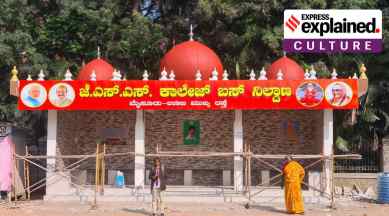Three domes and the controversy around the ‘mosque-like’ bus stop in Mysuru
After BJP MP Simha said the three domes atop the bus stop were making it look “mosque-like”, two of them have been removed. Do domes feature only in mosques, and do all mosques have them? Take a look.

The appearance of a bus stop in Mysuru has been changed following outrage and threats of demolition from Prathap Simha, the local BJP MP. Simha said three structures resembling domes atop the bus stop were making it look “mosque-like”. Two of these domes have now been removed.
Earlier this month, pictures of a bus stop in Mysuru went viral on account of its distinctive domed look. Mysore MP Simha demanded that the “mosque-like” structure be altered, failing which he said he would demolish it himself.
On November 27, the bus stop received a swift makeover. In a tweet, Simha reiterated his objection to the bus stop, saying, “If there is a big dome in the middle and two smaller domes next to each other, it is a mosque.” He thanked the local MLA and the district administration for their response.
The bus stop on NH-766 had a dome-like structure in the centre, flanked by two smaller domes on either side. Supposedly inspired by the design of the Mysore Palace, the construction of the bus stop was sanctioned by the local BJP MLA S A Ramdas.
Following Simha’s threat, Ramdas had the local authorities remove the two flanking domes. Currently the structure stands with just one dome-like structure on top.
“The bus stop shouldn’t be in controversy,” Ramdas said. “I constructed 12 bus stops across Mysuru inspired by the Mysore Palace. But it was given communal colour, and it has hurt me. After taking the opinion of seniors, I demolished two small gumbaz (domed) and retained the big gumbaz. People should not perceive it otherwise. The decision was taken in the interest of development.”
Karnataka Congress chief Salim Ahmed said, “Pratap Simha is an MP and he must know what he is speaking. There are government buildings with domes, will they demolish them?”
Earlier, on November 15, the National Highways Authority of India (NHAI) had also issued a notice saying “it is advised to remove the structure constructed to achieve controversial kind of issues”.
Is a dome the essential defining feature of a mosque?
In his tweet, Simha posted an illustration of a mosque along with the bus stand to prove this point. The question is, does this specific architectural feature appear only in mosques, and do all mosques look like this?
According to historian Percy Brown, who wrote a multi-volume classic on Indian architecture, mosque architecture is derived from the design of the Prophet’s house in Medina. Over time, that design has undergone refinement and additions depending on the place of construction. In India, the architecture of mosques evolved with regional variance, drawing on the skills of local artisans and stone masons.
The only necessary feature of any mosque is the mihrab – a small alcove on the wall which indicates the qibla or the direction of Mecca, which worshippers face while praying. In front of the mihrab there is an open space for worshippers to pray in. Beyond this, mosques can take various shapes and forms.
However, Brown says, “To produce the necessary structural effect of a ‘house of prayer’… above the central space corresponding to the ‘high place’ of a Christian Church, a dome was raised.” While the dome does not have ritual significance to a mosque, most mosques have one or more domes, symbolising the vault of heaven.
And does there have to be three domes in a mosque?
While domes can be seen as identifying features of a mosque, their number can vary greatly. For instance, in Bagherhat, Bangladesh, there exists a 15th century mosque called Shat Gombuj Mosjid or the 60-domed mosque. Nearer home, the Tipu Sultan mosque in Dharamtolla, Kolkata, has a large number of domes.
On the other hand, smaller mosques in villages or small towns might just have one central dome or no dome at all.
The three-domed mosque — with one larger central dome and two smaller domes — is, however, common across India. Delhi’s Jama Masjid, built during the reign of the Mughal Emperor Shah Jahan in the 17th century, and Bhopal’s Taj-ul Masjid have three major domes. Like the image tweeted by Pratap Simha, the three domed mosque is often seen in popular representations of mosques.
However, secular buildings may also have three domes – just as there are several large mosques that do not have any prominent domes.
What are the domes of the Mysore Palace like?
MLA Ramdas, who had commissioned the building of the bus stop, said that the structure was inspired by the Mysore Palace. The Mysore Palace was completed in 1912. Designed by British architect Henry Irwin and commissioned by the ruling Wodeyar dynasty, it drew inspiration from both Indian and European architectural styles.
Considered an epitome of the Indo-Saracenic Revival style of architecture (combining Persian, Rajput and Gothic elements), it is crowned by five pink marble domes around a gilded Persian style dome topped with a Rajput chhatri. The pink domes are extremely identifiable — not because of their shape, but because of their colour.
The domes atop the bus stand visibly drew inspiration from the Mysore palace with a bright reddish pink hue.